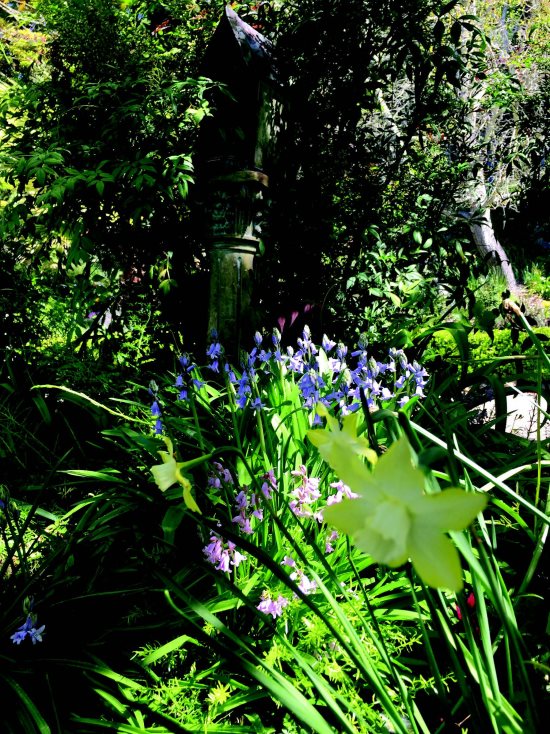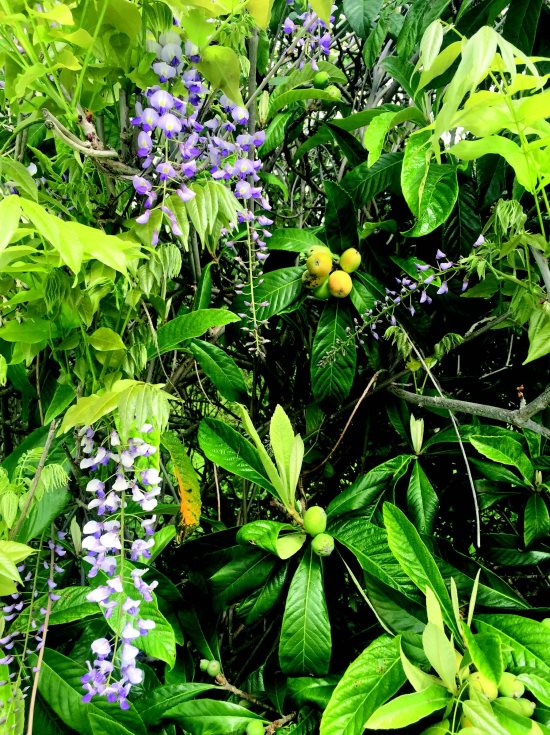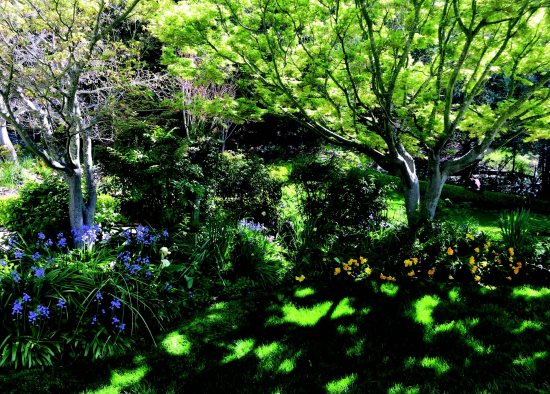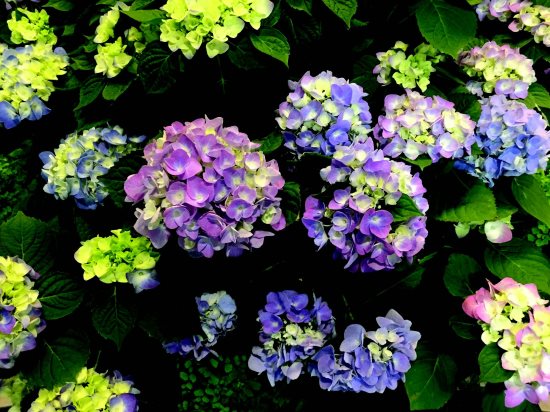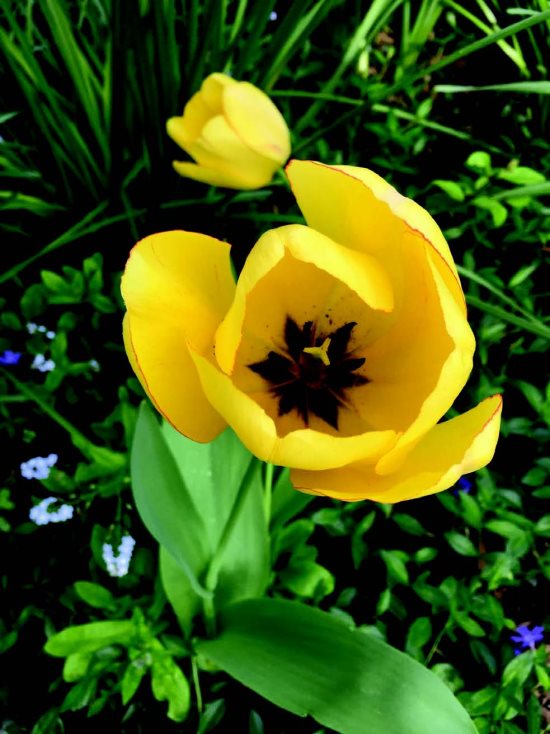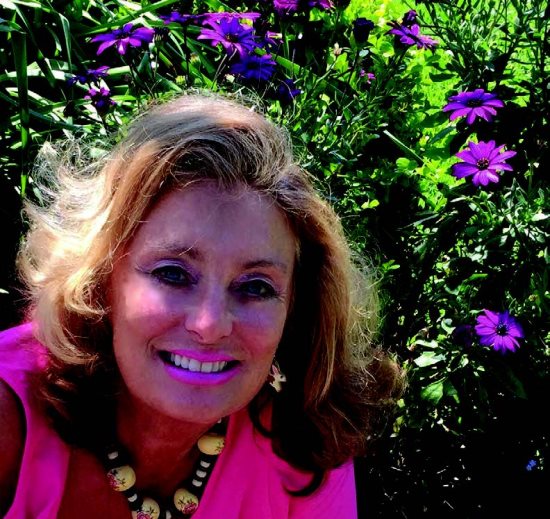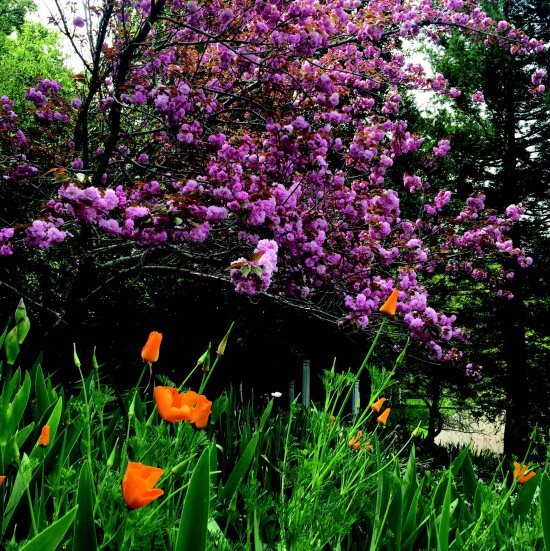 |
|
|
A flowering cherry thrives next to California redwoods and golden poppies. Photo Cynthia Brian
|
|
|
|
|
|
"The ax forgets, the tree remembers." African Proverb
 Do trees have feelings? Do they communicate with one another? As I watch the leaves unfurl and the blossoms bursting on the trees in my landscape, I have a sense that my trees are talking and communing with one another. With the celebration of Earth Day on the horizon, this was an opportune moment to research the language of trees.
Do trees have feelings? Do they communicate with one another? As I watch the leaves unfurl and the blossoms bursting on the trees in my landscape, I have a sense that my trees are talking and communing with one another. With the celebration of Earth Day on the horizon, this was an opportune moment to research the language of trees.
 At the insistence of his wife, German forester Peter Wohleben authored an accidental bestseller, "The Hidden Life of Trees: What They Feel, How They Communicate." The two of them live in a cabin in the remote village of Hummel where Peter manages a nature reserve. He has become a spokesman of sorts for protecting and respecting the rights of trees.
At the insistence of his wife, German forester Peter Wohleben authored an accidental bestseller, "The Hidden Life of Trees: What They Feel, How They Communicate." The two of them live in a cabin in the remote village of Hummel where Peter manages a nature reserve. He has become a spokesman of sorts for protecting and respecting the rights of trees.
 Although trees don't form words as humans do, they do communicate, and are more alert, sophisticated, and social than we expected. Trees form alliances with other trees of both their own species and others to survive and thrive. They connect via underground fungal mycorrhizal networks, a symbiotic relationship between tree roots and fungi. As they scavenge for nitrogen, phosphorus, and other nutrients, the fungi consume 30 percent of the sugar photosynthesized from sunlight then feed the trees. This fungal internet of thin threads known as mycelium can also transport toxins to keep competing plants from establishing nearby. Eucalyptus and sycamore commonly exhibit this behavior. Biologists have termed fungi-to-tree communication the "wood wide web," showcasing how interconnected and interdependent nature is.
Although trees don't form words as humans do, they do communicate, and are more alert, sophisticated, and social than we expected. Trees form alliances with other trees of both their own species and others to survive and thrive. They connect via underground fungal mycorrhizal networks, a symbiotic relationship between tree roots and fungi. As they scavenge for nitrogen, phosphorus, and other nutrients, the fungi consume 30 percent of the sugar photosynthesized from sunlight then feed the trees. This fungal internet of thin threads known as mycelium can also transport toxins to keep competing plants from establishing nearby. Eucalyptus and sycamore commonly exhibit this behavior. Biologists have termed fungi-to-tree communication the "wood wide web," showcasing how interconnected and interdependent nature is.
 Using pheromones and scent signals, trees also talk through the air. Research was done several years ago with acacias on the savannas of Africa. When giraffes began chewing on the leaves of the thorny acacia, the tree sensed the wound sending a distress signal in the form of ethylene gas to neighboring acacias. The trees receiving the message of imminent danger pumped quantities of tannins into their leaves, which can kill an herbivore.
Using pheromones and scent signals, trees also talk through the air. Research was done several years ago with acacias on the savannas of Africa. When giraffes began chewing on the leaves of the thorny acacia, the tree sensed the wound sending a distress signal in the form of ethylene gas to neighboring acacias. The trees receiving the message of imminent danger pumped quantities of tannins into their leaves, which can kill an herbivore.
 Trees differentiate between an animal attack and a human cutting a limb. When a branch breaks or is sawed off, the tree sends chemicals to heal the wound. And trees remember.
Trees differentiate between an animal attack and a human cutting a limb. When a branch breaks or is sawed off, the tree sends chemicals to heal the wound. And trees remember.
 Trees also have a sense of smell and taste. When an elm or pine is attacked by leaf-eating caterpillars, the affected trees detect the saliva. Pheromones are released to attract parasitic wasps. The wasps lay eggs inside the caterpillars, and the wasp larvae eat the caterpillars from the inside out.
Trees also have a sense of smell and taste. When an elm or pine is attacked by leaf-eating caterpillars, the affected trees detect the saliva. Pheromones are released to attract parasitic wasps. The wasps lay eggs inside the caterpillars, and the wasp larvae eat the caterpillars from the inside out.
 Dr. Suzanne Simard, a forest ecologist with the University of British Columbia is renowned for her extensive scientific research into mycorrhizal networks and "hub trees" or "mother trees" as she prefers to call the biggest, oldest forest trees. Mother trees are not necessarily female but they do have the most fungal connections to nurture and support the saplings. Their deep roots suck up water and send it to fellow trees along with other nutrients and distress warnings. Her lab studies found that defense signals traveled between a diversity of trees within six hours. Not all scientists agree with Simard and Wohleben that trees are sentient beings. Several scientists have countered that plants and trees do not possess intelligence and are instead genetically programmed by natural selection to do a job automatically.
Dr. Suzanne Simard, a forest ecologist with the University of British Columbia is renowned for her extensive scientific research into mycorrhizal networks and "hub trees" or "mother trees" as she prefers to call the biggest, oldest forest trees. Mother trees are not necessarily female but they do have the most fungal connections to nurture and support the saplings. Their deep roots suck up water and send it to fellow trees along with other nutrients and distress warnings. Her lab studies found that defense signals traveled between a diversity of trees within six hours. Not all scientists agree with Simard and Wohleben that trees are sentient beings. Several scientists have countered that plants and trees do not possess intelligence and are instead genetically programmed by natural selection to do a job automatically.
 Being the nature aficionado that I am, I vote for team Simard and Wohleben. Over the past few years I've been carefully studying my hillside pine trees as they twist to be closer to each other. Although each tree was originally planted to give a wide berth for each canopy to grow straight and tall in an effort to reach optimum sunlight, as the trees matured they tended to gravitate toward one another, mingling their branches. The pine that was planted furthest away from its siblings actually lurched sideways forming an arch until its branches touched the closest pine. I can't help but think that this small group considers itself a forest family or at least very dear friends. When my "mother" Japanese maple leafs out, the other two develop their leaves within two days. My fruit trees of the same species always bloom together as if on orchestral cue. The willows in the creek appear to be supporting the oaks and bays with a communal sharing of resources.
Being the nature aficionado that I am, I vote for team Simard and Wohleben. Over the past few years I've been carefully studying my hillside pine trees as they twist to be closer to each other. Although each tree was originally planted to give a wide berth for each canopy to grow straight and tall in an effort to reach optimum sunlight, as the trees matured they tended to gravitate toward one another, mingling their branches. The pine that was planted furthest away from its siblings actually lurched sideways forming an arch until its branches touched the closest pine. I can't help but think that this small group considers itself a forest family or at least very dear friends. When my "mother" Japanese maple leafs out, the other two develop their leaves within two days. My fruit trees of the same species always bloom together as if on orchestral cue. The willows in the creek appear to be supporting the oaks and bays with a communal sharing of resources.
 Simard detects a spiritual expression in the forest and Wohleben has been accused of being a tree hugger, although he states that he doesn't believe trees respond to human hugs. We do know for certain that trees provide beauty while cleaning the air, combating climate change, and absorbing CO2. They provide oxygen, keep us cool, prevent erosion, supply us with food, offer playtime for kids, and help us heal faster. Trees furnish us with wood for homes, furniture, and warmth while allowing wildlife to flourish and reside in their branches. An area without trees feels arid, vulnerable and ugly.
Simard detects a spiritual expression in the forest and Wohleben has been accused of being a tree hugger, although he states that he doesn't believe trees respond to human hugs. We do know for certain that trees provide beauty while cleaning the air, combating climate change, and absorbing CO2. They provide oxygen, keep us cool, prevent erosion, supply us with food, offer playtime for kids, and help us heal faster. Trees furnish us with wood for homes, furniture, and warmth while allowing wildlife to flourish and reside in their branches. An area without trees feels arid, vulnerable and ugly.
 Trees are our allies and they are definitely talking to us. Clear cutting and climate change will kill our trees and our forests. We need to plant trees to capture carbon and encourage kids of all ages to climb big trees. We need to acknowledge that global warming is real and that our trees are desperately warning us of the disasters to come if we don't create a movement for change. We need to listen to our vegetation as their memories are living, long, and lasting.
Trees are our allies and they are definitely talking to us. Clear cutting and climate change will kill our trees and our forests. We need to plant trees to capture carbon and encourage kids of all ages to climb big trees. We need to acknowledge that global warming is real and that our trees are desperately warning us of the disasters to come if we don't create a movement for change. We need to listen to our vegetation as their memories are living, long, and lasting.
 We are all one interdependent, interconnected community. Stop. Look. Listen. Learn the language of trees and celebrate Earth Day with me.
We are all one interdependent, interconnected community. Stop. Look. Listen. Learn the language of trees and celebrate Earth Day with me.
 Cynthia Brian's mid-month gardening guide for April
Cynthia Brian's mid-month gardening guide for April
 VISIT Wildlife Earth Day at Wagner Ranch in Orinda on Sunday, April 22 from 11:30 a.m. to 4 p.m. Several community organizations will also present earth-friendly endeavors. I will be autographing my newest book, "Growing with the Goddess Gardener" as well as talking about trees, flowers, and other botanicals. For more information on this nature-lover's event organized by the naturalist guru, Toris Jaeger, visit https://fwrna.org/wildlifefest/.
VISIT Wildlife Earth Day at Wagner Ranch in Orinda on Sunday, April 22 from 11:30 a.m. to 4 p.m. Several community organizations will also present earth-friendly endeavors. I will be autographing my newest book, "Growing with the Goddess Gardener" as well as talking about trees, flowers, and other botanicals. For more information on this nature-lover's event organized by the naturalist guru, Toris Jaeger, visit https://fwrna.org/wildlifefest/.
 ENJOY the lilacs and wisteria in full bloom.
ENJOY the lilacs and wisteria in full bloom.
 WATCH the leaves unfurl on your deciduous trees and become more aware of how different species of trees support one another.
WATCH the leaves unfurl on your deciduous trees and become more aware of how different species of trees support one another.
 REMOVE old foliage around the new growth of perennials.
REMOVE old foliage around the new growth of perennials.
 PREVENT disease and rotting by keeping mulch several inches away from stems of plants and shrubs.
PREVENT disease and rotting by keeping mulch several inches away from stems of plants and shrubs.
 CREATE a habitat for birds that prefer staying close to the ground by making a small pile of twigs and clippings in your side yard. You'll attract white-throated sparrows and dark-eyed juncos.
CREATE a habitat for birds that prefer staying close to the ground by making a small pile of twigs and clippings in your side yard. You'll attract white-throated sparrows and dark-eyed juncos.
 ADD a clean birdhouse to your landscape for birds to make their nests. You'll be the beneficiary of joyful tweets and twerps.
ADD a clean birdhouse to your landscape for birds to make their nests. You'll be the beneficiary of joyful tweets and twerps.
 UTILIZE the monthly gardening tips in the book, "Growing with the Goddess Gardener" available with free seeds, herbs, and more from http://www.CynthiaBrian.com/online-store.
UTILIZE the monthly gardening tips in the book, "Growing with the Goddess Gardener" available with free seeds, herbs, and more from http://www.CynthiaBrian.com/online-store.
 FERTILIZE fruit trees with a high nitrogen organic fertilizer. Best time is right before the bud break, although trees that need food can be fertilized through June. Don't fertilize in summer or fall.
FERTILIZE fruit trees with a high nitrogen organic fertilizer. Best time is right before the bud break, although trees that need food can be fertilized through June. Don't fertilize in summer or fall.
 PICK tulips for indoor vases.
PICK tulips for indoor vases.
 BUY discounted baseball tickets to the June 15 Oakland A's versus Los Angeles Angels directly at https://groupmatics.events/event/Bestar with a portion of proceeds benefitting the 501 c3 charity, Be the Star You Are(r)
BUY discounted baseball tickets to the June 15 Oakland A's versus Los Angeles Angels directly at https://groupmatics.events/event/Bestar with a portion of proceeds benefitting the 501 c3 charity, Be the Star You Are(r)
 http://www.BetheStarYouAre.org
http://www.BetheStarYouAre.org
 SCATTER pollinator friendly wild flower seeds to celebrate Earth Day.
SCATTER pollinator friendly wild flower seeds to celebrate Earth Day.

 Happy Gardening. Happy Growing.
Happy Gardening. Happy Growing.


|
Pretty in pink, Cynthia Brian loves her purple African daisies.
Cynthia Brian, The Goddess Gardener, raised in the vineyards of Napa County, is a New York Times best selling author, actor, radio personality, speaker, media and writing coach as well as the Founder and Executive Director of Be the Star You Are1(r) 501 c3. Tune into Cynthia's Radio show and order her books at
www.StarStyleRadio.com. Buy a copy of the new book, Growing with the Goddess Gardener, at www.cynthiabrian.com/online-store. Available for hire for projects and lectures.
Cynthia@GoddessGardener.com
www.GoddessGardener.com |

